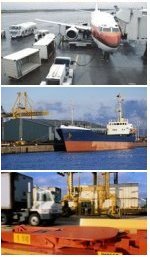

 |
 |
 |
Articles & Information<<Back to Articles/Information Index>> CUSTOMS ROLLED IN SUNSCREEN BLIND CASEIn the recent case of Mermet Australia Pty Ltd & Ors v CEO of Customs the tariff classification of sunscreen blinds was in issue. Louis Gross & Associates successful acted for Mermet Australia in having a decision by Customs to classify the goods to Chapter 54 overturned. Facts The goods were manufactured from a fibreglass yarn which was coated with PVC. The yarn was woven and then subject to a heat process which melded the PVC into the weave of the material giving it is rigidity and various characteristics of UV resistance. Customs claimed that the goods should be classified to heading 5407 as WOVEN FABRICS OF SYNTHETIC FILAMENT YARN. Mermet claimed the blinds should be classified to heading 3926 as OTHER ARTICLES OF PLASTICS or, alternatively, to heading 70019 as ARTICLES OF GLASS FIBRES. To be classified in Chapter 54 requires the yarn to be identified as a synthetic yarn. A synthetic yarn is defined as relating to an organic substance. Fibreglass is an inorganic substance. It was noted that the same goods had been in dispute in the USA. US Customs had rejected the argument that the goods were made of a synthetic yarn and sought to argue they were a fibreglass item. The US International Court of Trade held that the goods were a plastic item. Issues Customs sought to argue that the PVC coating of the fibreglass yarn was sufficient to have the yarn held as a synthetic yarn. There were exclusory Chapter Notes in both Chapter 59 and in Section XI which had to be dealt with. In addition, Customs sought to rely on the Interpretive Rules to overcome Chapter Notes. Rulings In a detailed and instructive decision, the Tribunal set out the principles of tariff identification and classification and usage of the Interpretive Rules. In particular, it confirmed that regard must be had first to the terms of headings and any relevant Section and Chapter Notes before having regard to the Interpretive Rules. Customs also tried to rely on Interpretive Rule 2(b). This Rule provides that a reference in the tariff to a material includes a reference to that material mixed with another material. Customs tried to argue that this Rule provided for the treating of the fibreglass yarn with a PVC coating as a PVC good. This was rejected by the AAT. They confirmed that the actual material – in this case the fibreglass yarn – had to be first identified before you could look at what it might be mixed with, e.g. if a synthetic filament yarn was mixed with linen, then Rule 2(b) would apply. One has to start with a synthetic filament yarn to apply Rule 2(b) to keep the goods within Chapter 54. In this case, the Tribunal found that the yarn was not a synthetic yarn because of its fibreglass basis. The Tribunal then applied the essential character test of Rule 3(b) to rule between the competing classifications of plastic items and fibreglass items and found that the plastic provided the essential characteristics of the goods. This accorded with the US decision, although no reference was made by the Tribunal to that case. Conclusion Mermet will stand as a very instructive case in tariff classification principles. The case is also illustrative of the detriment that occurs to Australian Customs' decision making processes when they are subject to pressure from local assemblers of the goods. This case had been subject to numerous reviews, all held in favour of Mermet initially but, on Ministerial enquiry, the decision was changed. This was despite the fact that the earlier reviews were carried out by senior tariff officers, together with the fact that there was an existing US Customs decision on the matter. Louis Gross. B.Juris., LL.B. |
|
|
Home |
Our Services |
Our People The information you obtain at this site is not, nor is it intended to be, legal advice.
Copyright ©2007 by Gross & Becroft lawyers . All rights
reserved. |